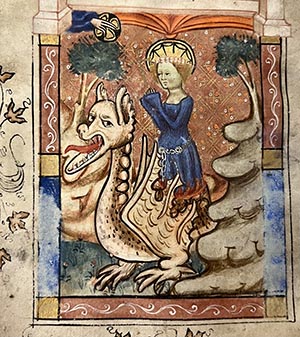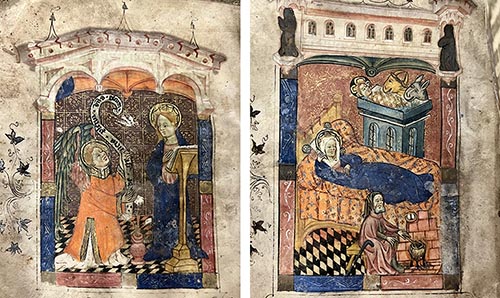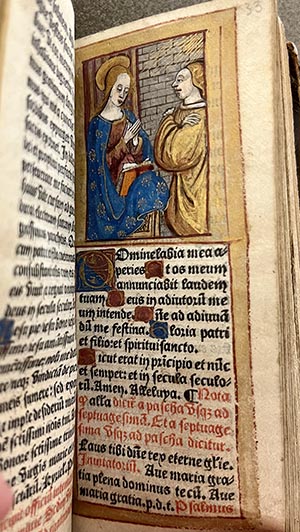Books of Hours: women’s literacy & religious lives
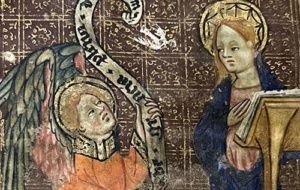 Coming out of what felt like an eternally long January, we are already nearing the end of February and looking forwards to March. March marks two international days that we in the Library hold dear: World Book Day on the 2nd and International Women’s Day on the 8th. In recognition of both these events, in this month’s Treasure we are exploring women’s literacy* and women’s participation in book culture by taking a look at the College’s Books of Hours — personal prayer books kept by laypersons for their private devotions. Although not exclusively made for women, Books of Hours were frequently gifted to brides upon marriage, and provided their readers with prayers, Gospel lessons, and a calendar of Holy days, affording laypeople the tools to practice daily worship independently of the church.
Coming out of what felt like an eternally long January, we are already nearing the end of February and looking forwards to March. March marks two international days that we in the Library hold dear: World Book Day on the 2nd and International Women’s Day on the 8th. In recognition of both these events, in this month’s Treasure we are exploring women’s literacy* and women’s participation in book culture by taking a look at the College’s Books of Hours — personal prayer books kept by laypersons for their private devotions. Although not exclusively made for women, Books of Hours were frequently gifted to brides upon marriage, and provided their readers with prayers, Gospel lessons, and a calendar of Holy days, affording laypeople the tools to practice daily worship independently of the church.
(*NB. Here we will only discuss the reading element of literacy, and not women’s writing.)
Books of Hours demonstrate the meticulous scheduling of time that comes with a life devoted to God. The “hours” of their name refer to the eight discrete times of day observed by the monastic Divine Office, those times “at which monks would gather at church to pray”¹ — beginning with waking for 2am prayers and ending with the evening compline (completion) for quiet reflection. While the layperson’s emulation of monastic ritual did not normally keep to such strict timekeeping, Books did provide an itinerary of sorts for worshippers to follow in their own time, along with the prayers and lessons required for worship.
The most intriguing aspect of Books of Hours is their “femaleness” and the place they afforded to women in book culture. Books of Hours were the most produced book genre in the medieval period, made in their thousands between the 13th and 16th centuries, and the majority of Books were made for women readers². Although Books of Hours were usually extensively and lavishly decorated, their visual quality did not minimize their literary content³. Books were written in Latin and contained multiple liturgical (worship in conduct of Divine service) texts, replicating those texts read by monks in their monastic studies. Indeed, the huge numbers of these books demonstrates that literacy amongst medieval women was far more prevalent than we might suppose of people living in the so-called dark ages4.
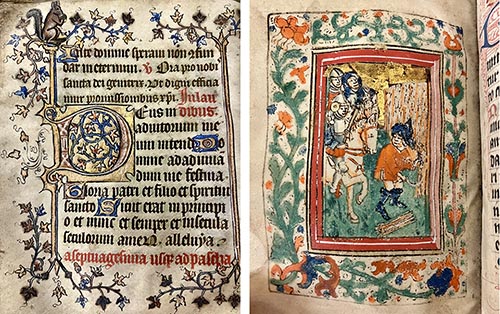
a decorative initial from Ms.5 (left) and an illumination depicting the reaping of crops from Ms. 8 (click for larger image)
We know that three of Univ’s Books of Hours were indeed owned by women at some point before entering the College’s collection. Page 127 of Ms.10 is inscribed with the name of its owner (though possibly not in her hand): “ce present livre appartient a Marguerite Gallot” or “this book belongs to Marguerite Gallot.” While a note on folio 4 of Ms.25 states that the book was formerly owned by Elizabeth Yate: “This booke p[er]teyneth to me Elyzabeth Yate”. Regrettably, though perhaps unsurprisingly, we do not know very much about Marguerite or Elizabeth.
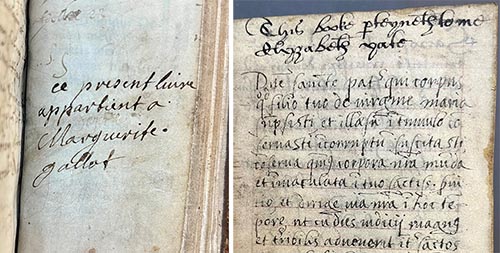
Ms.10, inscription declaring the ownership of Marguerite Gallot (left) and Ms.25 a note indicating the former ownership of Elizabeth Yate (click for larger image)
We do however know more about the former owner of Ms.5. This manuscript was probably owned by, and possibly made for, Jane Barwe, a Dominican nun and prioress of Dartford in Kent between 1377-14005. Nicholas Rogers notes that the private prayers that make up the book’s third section are written in the Latin feminine form, indicating that these were personalized to the intended owner. We can also trace this book to Dartford because, in addition to the Dominican saints, there is included a devotion to the memory of St. Margaret. In 1356, King Edward III dedicated the Dartford convent to “the virgin Mother of our Lord, and to the blessed virgin Margaret.”6 With her particular significance to Jane Barwe’s priory, and perhaps because she performed one of the most powerful and physically impressive miracles, Margaret is the only saint to be depicted in the illustrations of this manuscript. Here we can see her bursting through the spine of the dragon that had earlier devoured her.
This centring of female characters may have been integral in the Book of Hours’s appeal to women worshippers. All Books of Hours prominently featured the life of Mary the Virgin, with the Hours of the Virgin — a devotion to the mother of Christ— the central text of every book. Univ’s Ms.5 (above) depicts scenes from the Joys of the Virgin, the happiest moments in Mary’s life. Mary can be identified by her royal blue dress. On the left is an illustration of The Annunciation, when Mary was told she was pregnant with Christ, and on the right is the nativity scene following Jesus’s birth. Many Books of Hours would also include a scene illustrating the Adoration of the Magi, when the three kings or wisemen presented frankincense, gold and myrrh to Jesus. Univ’s manuscript does not include this scene, but the composition of the stable animals suggests this book artist has chosen to present instead the adoration of the ass and ox.
Books of Hours also afforded laywomen with a means of religious participation, without their having to join a convent. Each “hour” in the Book would contain a mix of psalm, hymn, prayers, and Old Testament readings, amongst other liturgical components. Each type of text was identified within the Book by an identifying rubric, or abbreviation. Here in Ms.10, we can see a decorative letter “O” precedes the text: this is for oratio, a prayer, which would indicate to the reader how she should read or perform the text.
At Univ we are lucky to have a small but well-preserved collection of Books of Hours. These beautiful books provide a fascinating insight into the private religious lives of medieval women, and oblige us to re-evaluate our preconceptions about the literacy and intelligence of communities from that vast period of history.
List of Books of Hours in the manuscript collection of University College
Ms.5 – 14th century Book of Hours, Use of Dominicans at Tréguier
Ms.8 – 15th century Book of Hours, Use of Sarum
Ms.10 – 16th century Book of Hours, Use of Rome
Ms.25 – 15th century Hours of the Holy Spirit (part 1), 16th century Psalter and Hymnal (part 2), 16th century Lectionary, hymnal, prayers with Litany (part 3)
Ms.179 – 15th century Devotional book, including Hours of the Blessed Virgin Mary
¹ Raymond Clements and Timothy Graham, Introduction to Manuscript Studies, page 208.
² Ibid.
³ Kathryn Kerby-Fulton, Naidie Hilmo and Linda Olson, Opening up Middle English Manuscripts: Literary and Visual Approaches, page 165.
4 Janina Ramirez, Femina: a new history of the Middle Ages, through the women written out of it.
5 Nicholas Rogers, “Oxford, University College MS.5: a Flemish book of hours for a Dominican nun,” in Maurits Smeyers and Bert Cardon (eds.) Flanders in a European perspective: manuscript illumination around 1400 in Flanders and abroad: proceedings of the International Colloquium, Leuven, 7-10 September 1993, page 222.
6 Ibid, 221.
Published: 21 February 2023
Further selected Univ Treasures are detailed below or explore the whole collection on our News and Features Treasures pages.

